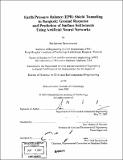Earth pressure balance (EPB) shield tunneling in Bangkok : ground response and prediction of surface settlements using artificial neural networks
Author(s)
Suwansawat, Suchatvee, 1972-
DownloadFull printable version (58.62Mb)
Other Contributors
Massachusetts Institute of Technology. Dept. of Civil and Environmental Engineering.
Advisor
Herbert H. Einstein.
Terms of use
Metadata
Show full item recordAbstract
Although Earth Pressure Balance (EPB) shields have been used for several decades, very little information exists about the actual mechanisms of shield-ground interaction. The ground response mechanism induced by EPB tunneling is difficult to understand, because this requires not only reliable ground deformation measurements in the field but also operational records of the shield. Numerous empirical and analytical relations between characteristics of traditional shields and surface and subsurface deformations exist; also 2-D and 3-D numerical analyses have been applied to such tunneling problems. However, very few approaches have been developed for EPB tunneling. This research makes use of the fact that in the Bangkok MRTA project, data on ground deformation and shield operation were collected. The tunnel sizes are practically identical and the subsurface conditions over long distances are comparable, which allow one to establish relationships between ground characteristics and EPB-operation on the one hand, and surface and subsurface deformations on the other hand. A computerized database, which records much of the information on a ring-by-ring (1.2 meter interval) basis, was developed for this purpose. After using the information to identify which ground- and EPB-characteristic have the greatest influence on ground movements, an approach based on Artificial Neural Networks (ANN) was used to develop predictive relations. Since the method has the ability to map input to output patterns, ANN enable one to map all influencing parameters to surface settlements. (cont.) Combining the extensive computerized database and the knowledge of what influences the surface settlements, ANN can become a useful predictive method. This research attempts to evaluate the potential as well as the limitations of ANN for predicting surface settlements caused by EPB shield tunneling and to develop optimal neural network models for this purpose. Specifically, this involves settlement predictions over the tunnel axes of single and twin tunnels; together with other interpretations, it is also possible to predict settlement troughs. Other shield effects such as lateral deformation and liner deformation of the first tunnel caused by the second tunnel are also evaluated.
Description
Thesis (Sc.D.)--Massachusetts Institute of Technology, Dept. of Civil and Environmental Engineering, 2002. Vita. Includes bibliographical references.
Date issued
2002Department
Massachusetts Institute of Technology. Department of Civil and Environmental EngineeringPublisher
Massachusetts Institute of Technology
Keywords
Civil and Environmental Engineering.